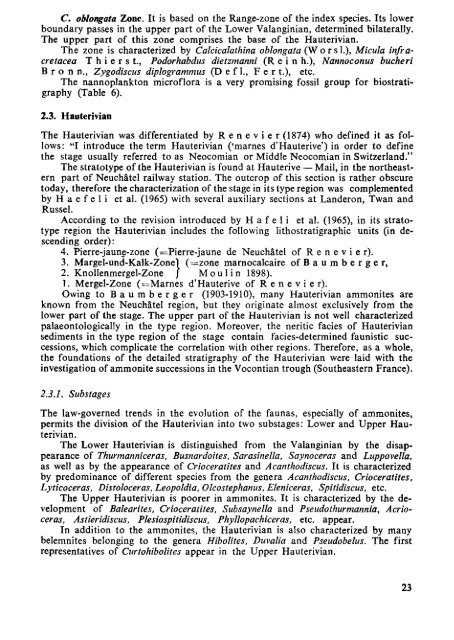THE MEDITERRANEAN LOWER CRETACEOUS
THE MEDITERRANEAN LOWER CRETACEOUS
THE MEDITERRANEAN LOWER CRETACEOUS
Create successful ePaper yourself
Turn your PDF publications into a flip-book with our unique Google optimized e-Paper software.
С. oblongata Zone. It is based on the Range-zone of the index species. Its lower<br />
boundary passes in the upper part of the Lower Valanginian, determined bilaterally.<br />
The upper part of this zone comprises the base of the Hauterivian.<br />
The zone is characterized by Calcicalathina oblongata (W or si.), Micula infracretacea<br />
T h i e г s t., Podorhabdus dietzmanni (Rein h.), Nannoconus bucheri<br />
В г о n п., Zygodiscus diplogrammus (D e f 1., Fer t.), etc.<br />
The nannoplankton microflora is a very promising fossil group for biostratigraphy<br />
(Table 6).<br />
2.3. Hauterivian<br />
The Hauterivian was differentiated byRenevier (1874) who defined it as follows:<br />
"I introduce the term Hauterivian ('marnes d'Hauterive') in order to define<br />
the stage usually referred to as Neocomian or Middle Neocomian in Switzerland."<br />
The stratotype of the Hauterivian is found at Hauterive — Mail, in the northeastern<br />
part of Neuchâtel railway station. The outcrop of this section is rather obscure<br />
today, therefore the characterization of the stage in its type region was complemented<br />
by H a e f e 1 i et al. (1965) with several auxiliary sections at Landeron, Twan and<br />
Russel.<br />
According to the revision introduced by H a f e 1 i et al. (1965), in its stratotype<br />
region the Hauterivian includes the following lithostratigraphic units (in descending<br />
order):<br />
4. Pierre-jaune-zone (=Pierre-jaune de Neuchâtel of R e n e v i e г).<br />
3. Margel-und-Kalk-Zone) (=zone marnocalcaire ofBaumberger,<br />
2. Knollenmergel-Zone J Moulin 1898).<br />
1. Mergel-Zone (=Marnes d'Hauterive of R e n e v i e r).<br />
Owing to Baumberger (1903-1910), many Hauterivian ammonites are<br />
known from the Neuchâtel region, but they originate almost exclusively from the<br />
lower part of the stage. The upper part of the Hauterivian is not well characterized<br />
palaeontologically in the type region. Moreover, the neritic facies of Hauterivian<br />
sediments in the type region of the stage contain facies-determined faunistic successions,<br />
which complicate the correlation with other regions. Therefore, as a whole,<br />
the foundations of the detailed stratigraphy of the Hauterivian were laid with the<br />
investigation of ammonite successions in the Vocontian trough (Southeastern France).<br />
2.3.1. Substages<br />
The law-governed trends in the evolution of the faunas, especially of ammonites,<br />
permits the division of the Hauterivian into two substages: Lower and Upper Hauterivian.<br />
The Lower Hauterivian is distinguished from the Valanginian by the disappearance<br />
of Thurmanniceras, Busnardoites, Sarasinella, Saynoceras and Luppovella,<br />
as well as by the appearance of Crioceratites and Acanthodiscus. It is characterized<br />
by predominance of different species from the genera Acanthodiscus, Crioceratites,<br />
Lyticoceras, Distoloceras, Leopoldia, Olcostephanus, Eleniceras, Spitidiscus, etc.<br />
The Upper Hauterivian is poorer in ammonites. It is characterized by the development<br />
of Balearites, Crioceratites, Subsaynella and Pseudothurmannia, Acrioceras,<br />
Astieridiscus, Plesiospitidiscus, Phyllopachiceras, etc. appear.<br />
In addition to the ammonites, the Hauterivian is also characterized by many<br />
belemnites belonging to the genera Hibolites, Duvalia and Pseudobelus. The first<br />
representatives of Curtohibolites appear in the Upper Hauterivian.<br />
23

















